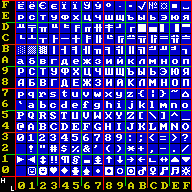Related Research Articles

Code page 850 is a code page used under DOS operating systems in Western Europe. Depending on the country setting and system configuration, code page 850 is the primary code page and default OEM code page in many countries, including various English-speaking locales, whilst other English-speaking locales default to the hardware code page 437.

Code page 855 is a code page used under DOS to write Cyrillic script.

Code page 866 is a code page used under DOS and OS/2 in Russia to write Cyrillic script. It is based on the "alternative code page" developed in 1984 in IHNA AS USSR and published in 1986 by a research group at the Academy of Science of the USSR. The code page was widely used during the DOS era because it preserves all of the pseudographic symbols of code page 437 and maintains alphabetic order of Cyrillic letters. Initially this encoding was only available in the Russian version of MS-DOS 4.01 (1990), but with MS-DOS 6.22 it became available in any language version.
Code page 852 is a code page used under DOS to write Central European languages that use Latin script.
Code page 860 is a code page used under DOS in Portugal to write Portuguese and it is also suitable to write Spanish and Italian. In Brazil, however, the most widespread codepage – and that which DOS in Brazilian Portuguese used by default – was code page 850.
Code page 863 is a code page used under DOS in Canada to write French although it lacks the letters Æ, æ, Œ, œ, Ÿ and ÿ.
Code page 857 is a code page used under DOS in Turkey to write Turkish.

Code page 737 is a code page used under DOS to write the Greek language. It was much more popular than code page 869 although it lacks the letters ΐ and ΰ.
Code page 869 is a code page used under DOS to write Greek and may also be used to get Greek letters for other uses such as math. It is also called DOS Greek 2. It was designed to include all characters from ISO 8859-7.
Code page 861 is a code page used under DOS in Iceland to write the Icelandic language.
Code page 862 is a code page used under DOS in Israel for Hebrew.
Code page 775 is a code page used under DOS to write the Estonian, Lithuanian and Latvian languages. In Lithuania, this code page is standardised as LST 1590-1, alongside the related Code page 778.
Code page 720 is a code page used under DOS to write Arabic in Egypt, Iraq, Jordan, Saudi Arabia, and Syria. The Windows (ANSI) code page for Arabic is Windows-1256.
Code page 851 is a code page used under DOS to write Greek language although it lacks the letters Ϊ and Ϋ. It covers the German language as well. It also covers some accented letters of the French language, but it lacks most of the accented capital letters required for French. It is also called MS-DOS Greek 1.
MacGreek encoding or Macintosh Greek encoding is used in Apple Macintosh computers to represent texts in the Greek language that uses the Greek script. This encoding is registered as IBM code page/CCSID 1280 and Windows code page 10006.
Code page 912 is a code page used under IBM AIX and DOS to write the Albanian, Bosnian, Croatian, Czech, English, German, Hungarian, Polish, Romanian, Serbian, Slovak, and Slovene languages. It is an extension of ISO/IEC 8859-2.
Code page 915 is a code page used under IBM AIX and DOS to write the Bulgarian, Belarusian, Russian, Serbian and Macedonian but was never widely used. It would also have been usable for Ukrainian in the Soviet Union from 1933–1990, but it is missing the Ukrainian letter ge, ґ, which is required in Ukrainian orthography before and since, and during that period outside Soviet Ukraine. As a result, IBM created Code page 1124. It is an extension of ISO/IEC 8859-5.
Code page 856, is a code page used under DOS for Hebrew in Israel.
Code page 868 is a code page used to write Urdu in Pakistan.
Code page 921 is a code page used under IBM AIX and DOS to write the Estonian, Latvian, and Lithuanian languages. It is an extension of ISO/IEC 8859-13.
References
- ↑ Character Sets, Internet Assigned Numbers Authority (IANA), 2018-12-12
- ↑ "CCSID 0865 information document". Archived from the original on 2016-03-26.
- ↑ "Code Page 865 MS-DOS Nordic". Developing International Software. Microsoft. Retrieved 7 Nov 2011.
- ↑ "Code page 0865 information document". Archived from the original on 2016-03-17.
- ↑ "cp865_DOSNordic to Unicode table" (TXT). The Unicode Consortium. Retrieved 7 Nov 2011.
- ↑ Code Page CPGID 00865 (pdf) (PDF), IBM
- ↑ Code Page CPGID 00865 (txt), IBM
- ↑ International Components for Unicode (ICU), ibm-865_P100-1995.ucm, 2002-12-03